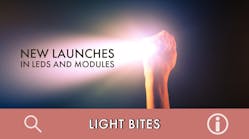IES publishes UV guidance and joins with IDA on outdoor SSL advice
The Illuminating Engineering Society (IES) has released a report on the use of ultraviolet (UV) emission in germicidal applications, specifically relative to usages in fighting the novel coronavirus SARS-CoV-2 that causes COVID-19. The report was rushed into existence because of the significant number of conflicting claims about UV-C band (100–280 nm) disinfection and the suspect and potentially-dangerous products being pushed into the market. Meanwhile, the IES and the International Dark Sky Association (IDA) have issued guidance on outdoor solid-state lighting (SSL) techniques that can limit light pollution.
Coronavirus report
The coronavirus UV report was authored by the IES Photobiology Committee. As we have reported previously, UV-C radiation can kill pathogens on surfaces, in air, and in water, almost instantaneously. But what is called germicidal ultraviolet irradiation (UVGi) is also a hazard for human skin and eyes. UV-C should be utilized in places where humans aren’t present, yet the IES notes companies are offering products such as disinfecting wands that could clearly be dangerous. Moreover, even products with disinfecting chambers must be designed in a manner to prevent the UV-C energy from escaping. Just last week, we covered a test instrument that can be used to verify safe operation of a product.
The new report was created with input from leading medical and research organizations and government agencies, including the US Centers for Disease Control and Prevention (CDC), the US Food and Drug Administration (FDA), Harvard Medical School, the Icahn School of Medicine at Mount Sinai Medical Center, and more.
Related article: Getting on the same wavelength with the experts
The IES is hoping to unleash UV-C technology on the coronavirus in safe ways while also ensuring that unsafe uses are eliminated. “The goal is to provide timely and objective information on a proven technology that can reduce the spread of this highly contagious virus,” said Brian Liebel, IES director of standards and research.
On its website, the IES has posted a direct link to the report, a FAQ, and an educational video. “The guidance included in this report should help medical professionals and consumers better understand germicidal UV products, and provides considerations for selecting and employing such technologies,” said Dr. David Sliney, chair of the IES Photobiology Committee.
Outdoor SSL and light pollution
Moving to safe outdoor lighting a night — meaning that it provides a safe environment for humans — the IES and IDA are prescribing an approach that will also protect the environment and ensure a night sky that people can enjoy. The guidance is the second instance in a week in which we have addressed effective outdoor lighting. Last week, we published a report from the Lighting Research Center (LRC) at Rensselaer Polytechnic Institute.
The IES and IDA guidance is far simpler, breaking down advice into five relatively simple principles of design and specification. “The Five Principles for Responsible Outdoor Lighting that unite our organizations are based on simple ideas; limit light at night to where and when it is needed, don’t overlight, and be sensitive to environmental concerns,” said Liebel of the IES. “Following these principles is not difficult and results in more effective and comfortable lighting installations.” The principles are being distributed in a simple graphic element by the organizations.

Maury Wright | Editor in Chief
Maury Wright is an electronics engineer turned technology journalist, who has focused specifically on the LED & Lighting industry for the past decade. Wright first wrote for LEDs Magazine as a contractor in 2010, and took over as Editor-in-Chief in 2012. He has broad experience in technology areas ranging from microprocessors to digital media to wireless networks that he gained over 30 years in the trade press. Wright has experience running global editorial operations, such as during his tenure as worldwide editorial director of EDN Magazine, and has been instrumental in launching publication websites going back to the earliest days of the Internet. Wright has won numerous industry awards, including multiple ASBPE national awards for B2B journalism excellence, and has received finalist recognition for LEDs Magazine in the FOLIO Eddie Awards. He received a BS in electrical engineering from Auburn University.





